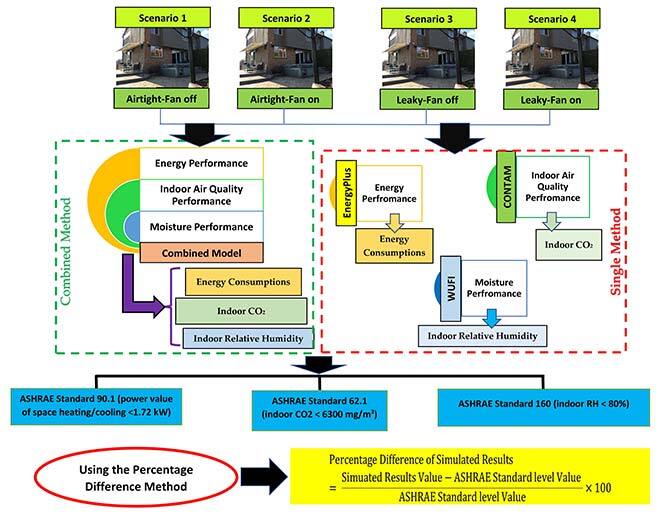Simulating Global Building Performance with a Combined Model

Purchased on Istockphoto.com. Copyright.
High-performance building analysis is influenced by the increasingly important measures of energy efficiency, indoor air quality and moisture performance, which should be considered as a whole. In this study, a model combining EnergyPlus, CONTAM and WUFI has been developed. Hourly space heating/cooling energy consumption as an energy measure, daily indoor CO2 concentration as an indoor air-quality measure, and indoor relative humidity (RH) as a moisture-performance measure were simulated by combining the three single models listed above. The simulated results of the combined and single models were compared based on the ASHRAE Standards 90.1, 62.1 and 160 in a case study of three-story houses in Montreal (Quebec, Canada), Vancouver (British Columbia, Canada) and Miami (Florida, USA). The differences in simulated results of the combined and single models were analyzed and discussed.
Assessing Global Building Performance—A Complex Task
In most research, energy modeling, indoor air quality and hygrothermal tools were used separately in predicting building performance [1-3]. Energy efficiency, indoor air quality (IAQ) and moisture performance are the most important measures in building performance analysis [4] and should be taken into consideration simultaneously. The necessity of combining the building performance measures is related to the positive and negative interaction between energy efficiency, indoor air quality and moisture performance.
As to the results on the negative interaction between energy efficiency and indoor air quality, Zender-Swiercz’s [5] research concluded that reducing outdoor air ventilation rates leads to increased concentrations of contaminants, and Stamp et al. [6] realized that increasing high concentrations of NO2 results in energy system strategies. As to the positive interaction between energy efficiency and indoor air quality, SeppȨnen [7] concluded that proper indoor air building designs lead to increased energy efficiency. In another study on the negative interaction between energy efficiency and moisture performance, Du and his team [8] found that increasing insulation thickness and improving airtightness can cause condensation and therefore increase mould growth risks. Ahmed and his team [9] found that replacing natural ventilation with mechanical air conditioning lead to reduced thermal comfort. In their study on positive interactions between energy efficiency and moisture performance, Pekdogan et al. [10], found that decreasing air pollution resulted from building wall-combined decentralized ventilation system strategies.
Based on reviewing the past and recent research on positive and negative interactions between energy efficiency, indoor air quality, and moisture performance, a combined model has been developed in this research.
Combined Model Architecture
The mechanism of combining Energy-IAQ and Moisture performance software is presented in Figure 1. In this combination, energy and IAQ software are coupled using a co-simulation method, where airflow and temperature are exchanged. As shown in Figure 1, IAQ software consists of two parts. IAQ software part 1 acts as the importer input data airflow, temperature, geometry, and other variables related to co-simulating as an IAQ file. IAQ software part 2 acts as the simulator of the predicted results.
Outputs simulated by the combined model of energy and IAQ software—which includes airflows, temperatures, and heating/cooling flows as energy-IAQ files—were used as input data to the moisture performance software. In the next step, the output, which includes airflows in the format of a moisture performance file, was used in IAQ software part 1 as airflows input data. This cycle procedure was iterated to exchange different scenarios with control variables of airflows, temperatures, and heating/cooling flows between all three modes of energy, indoor air quality, and moisture performance.
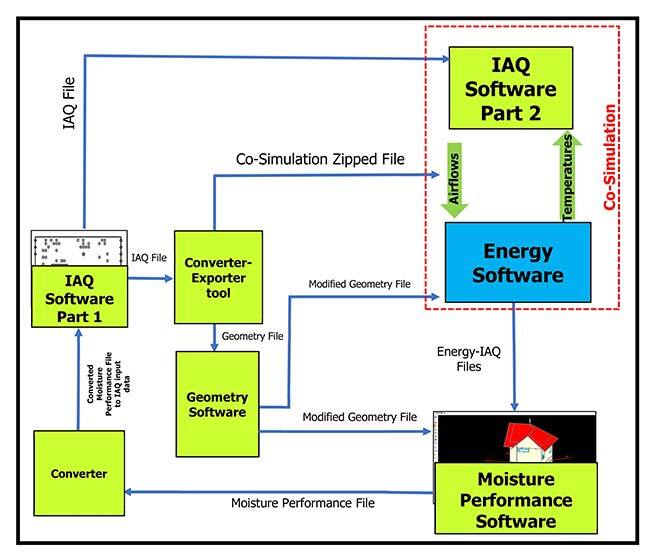
Figure 1. Combination mechanism of energy, indoor air quality (IAQ) and moisture performance software
The combined model was verified using the paired sample t-test method (for more details see [11-14]).
A Three-Story House as a Case Study in Four Scenarios
To analyze the difference between the results simulated with the combined model and those simulated with single models, a case study of three-story houses was defined. Four scenarios were chosen for this research: 1- Airtight Fan-off, 2- Airtight Fan-on, 3- Leaky Fan-off, and 4- Leaky Fan-on.
In the airtight fan-off scenario, an effective leakage area of 0.04 m2 was considered. The airtight fan-on scenario had an effective leakage area of 0.04 m2 and an exhaust fan flow rate of 24 L/s. In the leaky fan-off scenario, the effective leakage area was set at 0.3m2. Finally, the leaky fan-on scenario had an effective leakage area of 0.3 m2 and an exhaust fan flow rate of 24 L/s.
All simulations were performed for combined and single models with the same assumptions in three different climate conditions: cold-humid (Montreal), moderate-humid (Vancouver), and warm-humid (Miami).
The results simulated with the combined model and EnergyPlus include hourly space heating/cooling energy consumption. Results simulated with the combined model and CONTAM include daily indoor CO2 concentrations. Finally, results simulated with the combined model and WUFI include hourly indoor relative humidity (RH).
Results were converted as percentage differences of ASHRAE standards to avoid dealing with different dimension measurements, as shown in Figure 2, and were averaged on a one-year period.
Optimal Scenarios Depending on Climate Conditions
Optimal scenarios in this research were selected based on their minimal differences from the acceptable level of ASHRAE Standards for both combined and single models.
Figure 3 presents simulation outputs for hourly space heating/cooling energy consumption for the four scenarios, in Montreal, Vancouver and Miami. The airtight fan-off scenario is the optimal scenario for both the combined model and EnergyPlus for the three cities. In this scenario, values predicted by the combined model are -2.03%, -1.82%, and -7.78% from those predicted by EnergyPlus for Montreal, Vancouver and Miami, respectively.
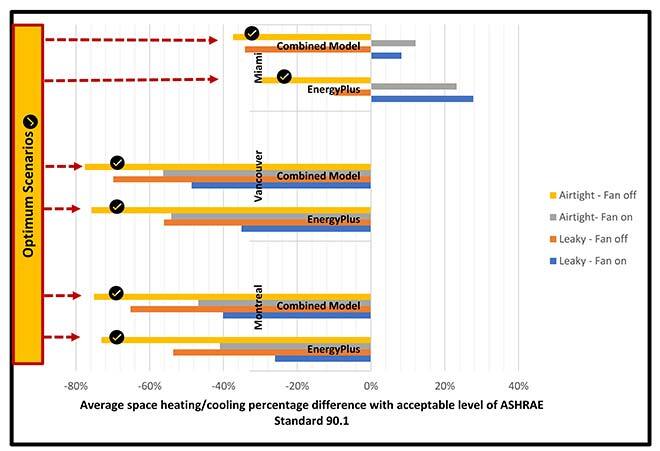
Figure 3. Comparison of optimal scenarios predicted with the combined model and EnergyPlus in Montreal, Vancouver and Miami
Figure 4 presents the simulation outputs of daily indoor CO2 concentrations for the four scenarios in Montreal, Vancouver and Miami. In Montreal and Vancouver, the optimal scenario is the leaky fan-on scenario for both the combined model and CONTAM. In this scenario, values predicted with the combined model are -2.28% and -2.46% compared to those predicted by CONTAM for Montreal and Vancouver, respectively.
In Miami, the leaky fan-on scenario is still optimal when CONTAM is used alone, but with the combined model, the airtight fan-on and leaky fan-on are comparable. The values of the optimal scenarios predicted with the combined model are -3.22% compared to the optimal scenario predicted by CONTAM.
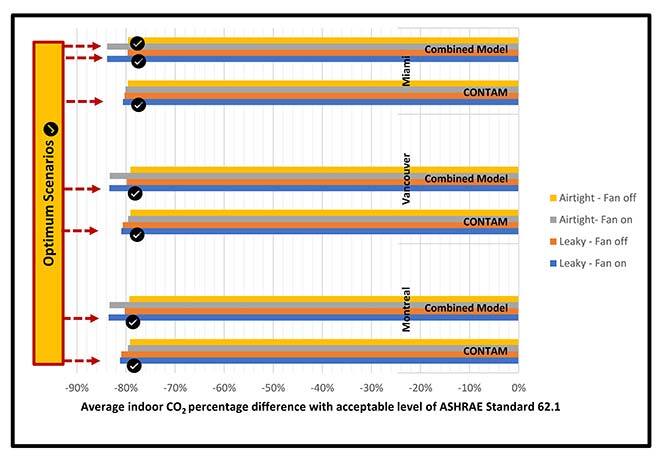
Figure 4. Comparison of optimal scenarios predicted with the combined model and CONTAM in Montreal, Vancouver and Miami
Figure 5 presents simulation outputs for hourly relative humidity (RH) for the four scenarios in Montreal, Vancouver and Miami. The leaky fan-on scenario is the optimal scenario when WUFI is used alone in Montreal, Vancouver and Miami. However, with the combined model, the airtight fan-on scenario becomes the optimal scenario in Montreal, and the airtight fan-off, the optimal scenario for Vancouver and Miami. The predicted values of the combined model for the optimal scenarios are 54.76%, 47.64% and -5.54% compared to those predicted with WUFI for Montreal, Vancouver and Miami, respectively.
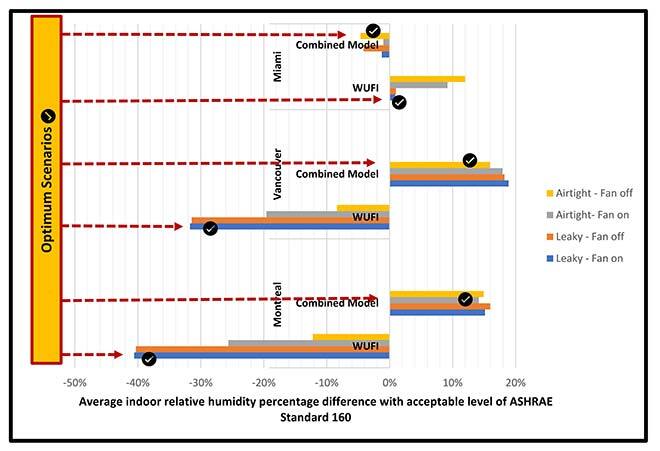
Figure 5. Comparison of optimal scenarios predicted with the combined model and WUFI in Montreal, Vancouver and Miami
The advantage and innovation of this research lie in the combined model, due to the possibility of exchanging the control variables of airflow, temperature, and heating/cooling flow. In a cyclic loop between the sub-models, the optimal scenarios can be predicted based on the ASHRAE Standards. But in the single models, the input data of airflow, temperature and heating/cooling flow are defined by the user.
Acknowledgments
We acknowledge the partial financial contribution of my thesis by Natural Sciences and Engineering Research Council of Canada (NSERC).
Additional information
For more information, please refer to the following articles published in the Energies journal.
Heibati, S.; Maref, W.; Saber, H.H. Assessing the Energy and Indoor Air Quality Performance for a Three-Story Building Using an Integrated Model, Part One: The Need for Integration. Energies 2019, 12, 4775. https://doi.org/10.3390/en12244775
Heibati, S.; Maref, W.; Saber, H.H. Assessing the Energy, Indoor Air Quality, and Moisture Performance for a Three-Story Building Using an Integrated Model, Part Two: Integrating the Indoor Air Quality, Moisture, and Thermal Comfort. Energies 2021, 14, 4915. https://doi.org/10.3390/en14164915
Heibati, S.; Maref, W.; Saber, H.H. Assessing the Energy, Indoor Air Quality, and Moisture Performance for a Three-Story Building Using an Integrated Model, Part Three: Development of Integrated Model and Applications. Energies 2021, 14, 5648. https://doi.org/10.3390/en14185648

